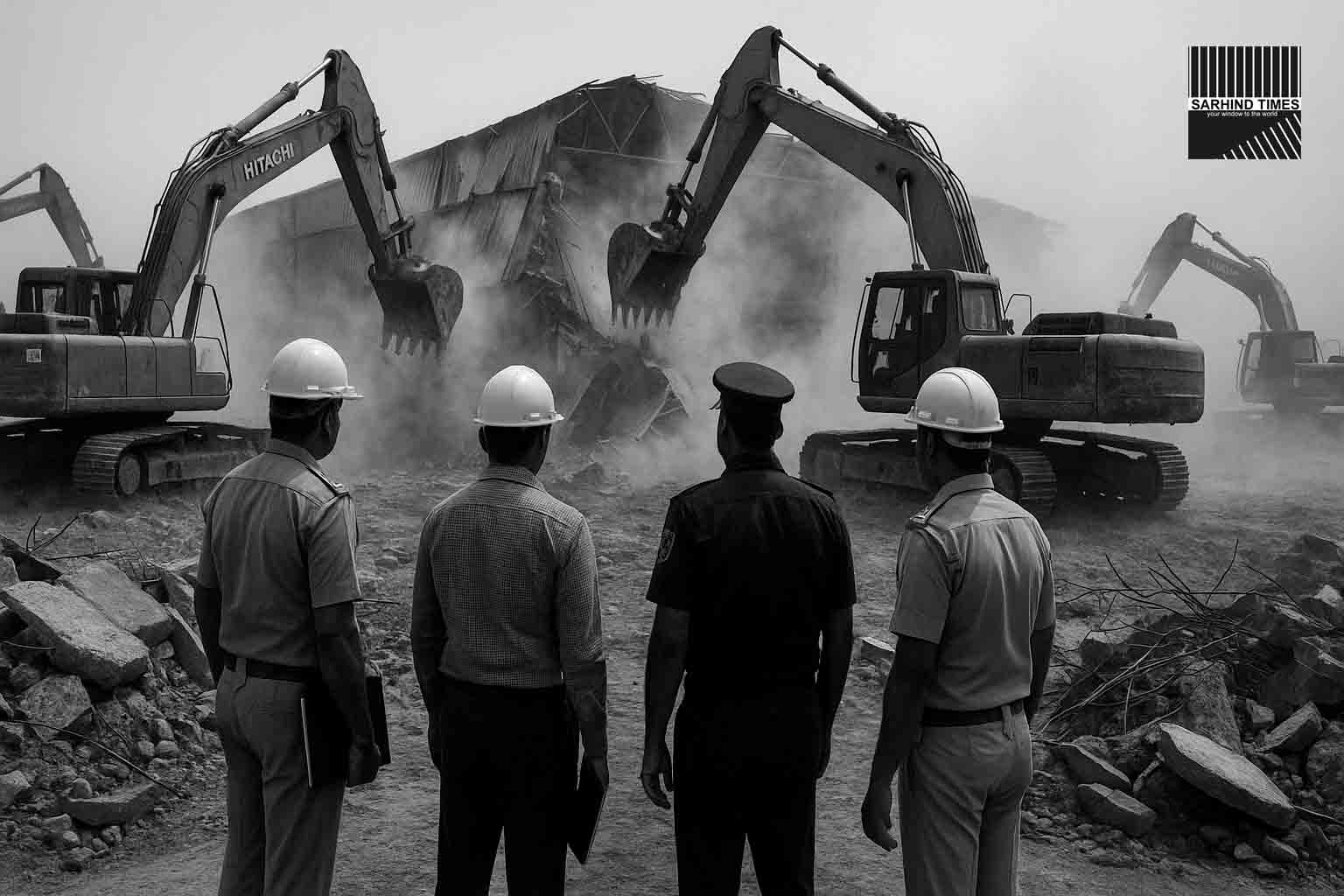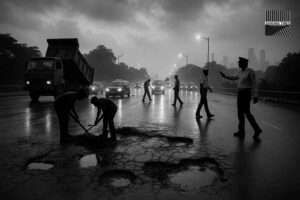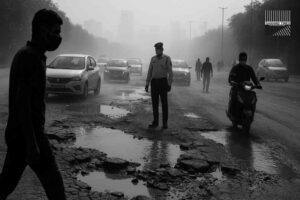The Department of Town and Country Planning (DTCP) intensifies its citywide enforcement drive, flattening unauthorized warehouses, demolishing boundary walls, and warning property buyers against investing in unlicensed colonies.
Gurgaon | October 11, 2025
In a decisive move to restore urban order and curb unregulated development, the Department of Town and Country Planning (DTCP), Haryana, carried out a large-scale demolition drive in Bilaspur on the outskirts of Gurgaon. The operation, conducted under tight police security, saw two massive unauthorized warehouses—spanning nearly 25,000 square feet—brought down alongside a 200-metre-long illegal boundary wall.
The department said the owners had repeatedly ignored prior warnings and notices, forcing officials to deploy bulldozers to reclaim encroached land. This is part of an ongoing citywide campaign targeting unauthorized real estate activity that has plagued Gurugram’s rapidly urbanizing peripheries.
The Action on Ground
Officials, accompanied by enforcement squads and police personnel, arrived early Friday morning at the Bilaspur site. According to field reports, the warehouses were built without mandatory change-of-land-use (CLU) permissions on agricultural land. The structures—used partly for commercial storage and logistics—lacked fire safety certification, structural approvals, and environmental clearance.
“Despite multiple notices and opportunities for compliance, the owners failed to respond. This forced the department to initiate demolition under Section 10 of the Haryana Development and Regulation of Urban Areas Act,” said a senior DTCP officer supervising the drive.
The team used excavators and hydraulic hammers to dismantle steel frameworks, brick walls, and roofing sheets, ensuring that no part of the unauthorized construction remained. Police cordoned off the surrounding area to prevent crowding and potential resistance.
Farrukhnagar Follow-Up
The Bilaspur crackdown follows a similar operation in Farrukhnagar last week, where officials demolished two sprawling illegal colonies spread across seven acres. The colonies had emerged in violation of zoning regulations, with 14 structures razed and partial internal roads dug up to prevent reoccupation.
According to DTCP’s inspection report, the colonizers had attempted to carve out small plots on agricultural and revenue land, advertising them to unsuspecting buyers as “ready-to-build” sites. “Such colonies are neither legally sanctioned nor structurally safe. They lack sewerage, drainage, and power infrastructure, leading to long-term civic chaos,” said an enforcement inspector.
Officials emphasized that the crackdown is part of a broader policy of “zero tolerance for unlicensed development.” The department has directed all district teams to identify and act against colonies mushrooming in Sohna, Pataudi, and Manesar, which have seen a surge in land conversion activity after the pandemic.
A City Strained by Unplanned Growth
Gurgaon’s meteoric rise—from a sleepy suburb to a global business hub—has brought prosperity but also problems. The city’s outskirts have witnessed a chaotic land rush, with farmland rapidly converted into industrial sheds, warehouses, and residential enclaves.
Many of these structures operate outside the regulatory framework, creating parallel economies and undermining public safety. Unauthorized colonies lack fire exits, sewage systems, rainwater harvesting facilities, and building stability checks.
A senior urban planner described it as “growth without governance.”
“What we see in Gurgaon’s peripheries is speculative urbanization. Landowners convert fields into plots overnight and sell them without approvals. Buyers, lured by low prices, become victims of future demolitions or non-registration,” he said.
The DTCP’s renewed vigor signals an attempt to reassert state control over the city’s urban narrative—a narrative that often swings between global ambitions and local anarchy.
Public Reaction: Between Support and Shock
The demolition drive drew mixed reactions from residents and business owners. While many hailed the move as overdue, some affected parties claimed inadequate notice and financial ruin.
“I invested my savings into a small warehouse. We applied for approvals but got caught in paperwork delays. Now everything is gone,” said one local trader who witnessed his property collapse under the bulldozer’s roar.
Others, however, welcomed the action. “These illegal constructions block drainage, increase flooding, and create fire hazards. The government must act tough,” said Anjali Mehta, a resident of Sector 10A.
Civil society groups echoed this sentiment, pointing out that unchecked construction fuels both environmental degradation and infrastructure strain.
Legal Foundation of the Crackdown
Under the Haryana Development and Regulation of Urban Areas Act, 1975, any person or entity developing land for residential, commercial, or industrial purposes must obtain a license and change-of-land-use (CLU) permission. Failure to do so can invite demolition, sealing, or prosecution.
The Act empowers DTCP to:
- Identify unauthorized development.
- Issue notices for voluntary removal or compliance.
- Conduct demolitions under police protection if ignored.
- Recover demolition expenses from violators.
The law also imposes penalties, including fines up to ₹50,000 and imprisonment for repeat offenders. DTCP officials have clarified that further cases will be referred to the district magistrate for criminal proceedings if non-compliance continues.
Mapping Unapproved Sectors
One of the key elements of the ongoing mission is satellite-based mapping. The DTCP has collaborated with the Haryana Space Applications Centre (HARSAC) to identify clusters of illegal plots and colonies across Gurgaon district.
Officials say the data-driven approach allows them to prioritize hotspots and take swift enforcement action. The mapping also helps track previously demolished areas to ensure they are not reoccupied or rebuilt clandestinely.
“We’re not just demolishing structures. We are reclaiming the city’s future,” a senior official said, underscoring the government’s message of planned and sustainable urbanization.
Impact on Property Buyers
The crackdown has sent shockwaves through the local property market, especially among buyers who invested in farmhouse projects or small plots advertised as “approved colonies.”
DTCP has urged citizens to verify land titles, licenses, and CLU status before investing. The official website offers a searchable database of licensed projects, layout approvals, and developer credentials.
Consumer rights advocates suggest the state should also establish a redressal mechanism for innocent buyers who purchased property in good faith but now face losses.
“The government must combine enforcement with empathy. Many buyers are victims, not culprits,” said housing policy expert R. K. Sharma.
Urban Experts Weigh In
Urban governance experts say that while demolitions are necessary to enforce order, long-term solutions lie in transparent land use reforms, affordable housing, and community participation.
Dr. Nandita Basu, an urban studies researcher, explained:
“The root cause of illegal colonies is affordability. People seek cheaper alternatives outside licensed areas. Unless planned housing supply matches demand, the informal market will fill the void.”
She recommended that the government adopt inclusive zoning policies, enabling small-scale developers to obtain clearances easily without prohibitive costs.
The Broader Pattern
Gurgaon’s demolition drive mirrors similar campaigns across India—be it Delhi’s anti-encroachment sweeps, Mumbai’s coastal clearance enforcement, or Hyderabad’s illegal layout demolitions.
Experts note that rapid urbanization and opaque land laws create fertile ground for such violations. Enforcement, though often unpopular, becomes essential to preserve civic order and infrastructure balance.
Environmentalists, meanwhile, warn that the problem is systemic: construction without planning strains natural drainage systems, increases flood risk, and worsens air pollution through unregulated debris handling.
The Way Forward
The DTCP has outlined several next steps:
- Monthly demolition targets for each district enforcement team.
- Online license verification portal for the public.
- Helpline for anonymous complaints against illegal developers.
- Coordination with police and revenue departments for integrated enforcement.
The administration also plans to issue public advisories in newspapers and social media, warning citizens against buying property without DTCP clearance.
A City at a Crossroads
As bulldozers rumble across Gurgaon’s edges, the message is clear: unauthorized growth will no longer be tolerated. Yet, the challenge is far from over. For every wall torn down, new walls are quietly erected elsewhere.
The battle for Gurgaon’s future will not be won by demolitions alone but by ensuring accessible, lawful, and sustainable development that serves both investors and the common citizen.
DTCP’s crackdown is both a warning and a wake-up call—a reminder that in the race to urbanize, legality and planning cannot be optional.
Conclusion
Gurgaon’s transformation from farmland to financial powerhouse has been breathtaking. But the same speed that propelled its skyline has also fueled chaos. The current drive is an attempt to restore balance, uphold the rule of law, and protect the integrity of urban India.
The challenge now is to sustain momentum—not just with bulldozers, but with blueprints for better governance.
#Gurgaon #DTCP #UrbanPlanning #IllegalColonies #Haryana #CivicAction #RealEstate #RuleOfLaw #CityNews #SmartCity #SustainableGrowth #Bilaspur #Farrukhnagar #SarhindTimes






















+ There are no comments
Add yours